1727, Fula Muslims defeat a larger force of Fula “infidels” at Talansan in the Futa Djallon highlands of Guinea. Karamokho Alfa, leader of nearby Timbo, then launches a jihad against neighboring traditional kingdoms. By 1750, he establishes a Fula imamate, which institutes sharia law.
This is the first of several Muslim states formed in West Africa, but Islam doesn’t move much further south in decades to come.
1727, 12 Ursaline Sisters arrive in New Orleans from France, and soon open a convent and a boarding school, the oldest continually operating Catholic School in the U.S. Much later, they hold first classes in the U.S. for free women of color, for female slaves and for Native Americans.

Woman warrior, Dahomey.
1727, Agaja, king of Dahomey (present-day Benin), completes conquest of Allada and Whydah (5,000 die in battle for the latter). His Fon people war on all neighbors, including dominant Oyo Empire, and bring captives to capital of Abomey. Month-long Annual Customs include decapitation of 500 captives in name of Fon ancestors. The several thousand remaining slaves are traded, often for guns, to Portuguese, French, Dutch and, later, British factories in Whydah.
Legend: The Allada leader, Gaou Guinou and his wife are among those sold as slaves to French. He eventually is taken to Saint-Domingue and starts a new family (presumably as a slave).
Much later, Gaou Guinou is said to have been the grandfather of Touissaint Loverture.
Women warriors: Dahomey’s aggressive military includes the Mino (Our Mothers), women warriors who train intensely, and regularly deploy in battle and slave raids. They include free Fon and young captives; none are married. Their female commanders take part in king’s grand council. Mino fight well into 19th century, when they number several thousand and suffer many casualties against better-armed French army.
1727, Second mass emigration of Scots-Irish from Ulster follows third consecutive poor harvest. Nearly 300,000 depart Ireland by 1760, most going to North American colonies.
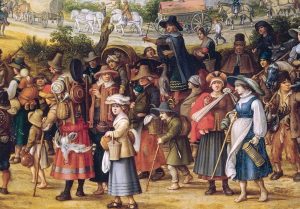 Leaving the Palatine.
Leaving the Palatine.
1727, Second, larger wave of Palatine and other south German families begins emigration to Philadelphia. Refugees from ongoing wars, they include Mennonites and other dissenters, but most are Lutheran and Reformed church members.
Estimated at 65,000 by 1775, many arriving as indentured servants. When free of that, most establish farms in counties north and west of Philadelphia as "the Pennsylvania Dutch."
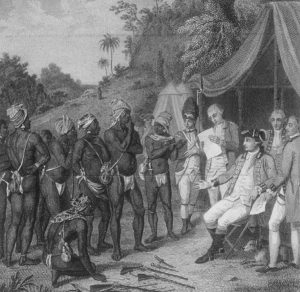 Maroons negotiate freedom.
Maroons negotiate freedom.
1728-1740, Escaped slaves defend several mountain communities (Windward Maroons under Queen Nanny and Leeward Maroons under Cudjoe) against British settlers (down to about 3,000) and soldiers. Tactics foreshadow guerrilla warfare. Sugar production declines. Ends with a negotiated peace and land grants to Maroons; in turn, they agree to return future fugitive slaves to plantations.
A significant number of slaves on Jamaica are said to be Ashanti.
1728, Oyo cavalry strikes back at Kingdom of Dahomey, whose Fon army has firearms and builds trenches to counter horses. Oyo (Yoruba people) attack Dahomey seven times before finally subjugating it in 1748. These wars generate considerable captives for slave trade on all sides, particularly the trans-Atlantic.
1729, Natchez and Yazoo people, provoked by a French commander’s demand that they turn over a burial ground for his plantation, surprise and kill 230 male settlers and burn Fort Rosalie (present-day Natchez, MS) but spare captured women, children and black slaves.
French retreat to New Orleans, ally with Choctaw and defeat Natchez and Yazoo, 1730. Thousands of Indians are enslaved, many of them sent to Saint-Domingue and other French colonies. Yazoo survivors absorbed by Chickasaw; Muscogee take in Natchez.
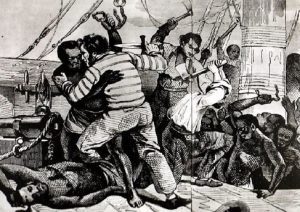 Slaves take ship.
Slaves take ship.
1730, Five days after departing Banana Islands (off present-day Freetown) 96 captives on Little George slip out of chains, break down a bulkhead, kill three watchmen, threaten to blow up ship with a quickly made bomb and win surrender of Capt. George Scott and crew, June 6.
Little George was returning home to Newport, RI; she was owned by merchant Godfrey Malbone, known for his 1741 mansion in Newport.
Africans sail ship to Sierra Leone river where they regain land. Capt. Scott and crew, left behind, tell the tale to another slaver crew that picks them up.
1730, Great Awakening brings evangelical and revivalist fervor to churches and open fields in Britain and, by 1740, to its American colonies, North to South. While this spurs some slave masters to bring the evangelical word to their slaves, it does not ignite widespread anti-slavery or abolitionist feelings. Leaders include George Whitefield (who owns slaves), John and Charles Wesley, and George Tennent.
John Wesley is the most outspoken against slavery, particularly in Thoughts Upon Slavery, published in London in 1774. A week before his death in 1791, Wesley writes to encourage William Wilberforce in his early efforts to abolish the slave trade.
1730, Eruptions on Lanzarote, in the Canaries, will continue for six years, creating 32 small volcanoes, the smoky Montañas del Fuego and lava fields covering a quarter of the land.
Islanders are thus quick to answer the crown’s call for emigrants to Cuba and Texas. Sixteen Canary families, the Ileños, most from Lanzerote, become the first civilian settlers of San Antonio, TX, in March 1731.
1731, Population of Santiago (largest of Cape Verde Islands): 17,709, of which 2% are white; 15% are mixed race; 16% are black slaves and the remaining 67%—11,919—are freed blacks (forros).
1732, George Washington is born to a wealthy tobacco plantation family on Pope’s Creek, VA, where it meets Potomoc, Feb. 22. When his father dies in 1743, he inherits a small plantation and 10 slaves managed by George’s half-brother. He becomes a county surveyor at age 17, a militia officer at 19.
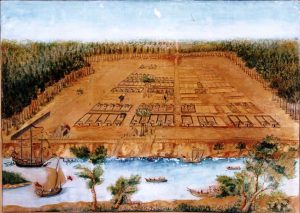 Savannah's first squares.
Savannah's first squares.
1733, First 116 settlers arrive at Savannah to establish colony of Georgia under the plan of their leader, James Oglethorpe: Land is designated for the “worthy poor” of England’s debtors’ prisons who will also serve as a buffer between Carolinas and Spanish Florida. Slavery and alcohol are banned, the only British colony to prohibit either. But it doesn’t last.
Oglethorpe had been inspired earlier in year to resign from deputy governorship of the Royal African Company by a letter from an enslaved Fulani from Senegal—Ayuba Suleiman Diallo—whom Oglethorpe then bought and freed.
Oglethorpe wins site of Savannah in negotiations with Yamassee, the survivors of 1715 war with Carolina settlers.
1733, Insurrection on St. John, Danish Virgin Islands, as 150 Akwamu slaves (from Gold Coast) seize Coral Bay fort, Nov. 23. Many of island’s 206 whites killed. Planters regain control following May with French and Swiss troops from Martinique.
Total slaves number 1,000-plus; some groups stay loyal to planters (they fear Akwamu intend to enslave them). At least one slave rewarded with freedom and an estate. Breffu, a woman leader, and 23 others commit suicide.
1738, Smallpox epidemic sweeps through Cherokee villages in Carolinas and Georgia, killing nearly half the population over two years. Still more, disfigured and despairing, take their own lives.
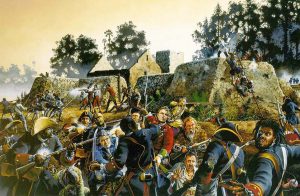 Blacks fight for Spanish.
Blacks fight for Spanish.
1738, Spanish governor of Florida directs construction of Fort Mose north of St. Augustine. This becomes a free black settlement for ex-slaves who escape from Carolina, accept Catholicism and are willing to serve as St. Augustine’s first line of defense.
First commander is Francisco Menéndez, a Mandinka from Gambia who fled a Carolina plantation for St. Augustine.
1738, Benjamin Lay confronts Yearly Meeting of his fellow Philadelphia Quakers (in Burlington, NJ) with diatribe against slavery, plunging a sword into a Bible and releasing blood-red juice.
Lay’s pamphlet, All Slave Keepers that Keep the Innocent in Bondage, Apostates, printed the previous year by his friend Benjamin Franklin, calls upon slave-holding Quakers to free the enslaved. Most of them will do just that by the time of the Revolution.
1738, The Leusden, with 700 slaves aboard, capsizes in a storm in the mouth of Surinam’s Moroni river in worst known slave-ship disaster, Jan. 1. As the Dutch West India ship slowly sinks in shallow water, crew deliberately nails down hatches, trapping enslaved below; only 16, already on deck, survive.
Later, Capt. Joachim Outjes testifies that slaves might otherwise have escaped and set off a revolt. He is acquitted of wrongdoing.
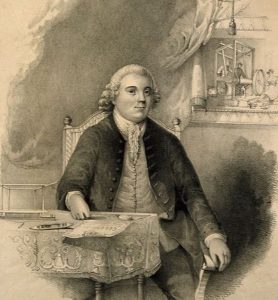 John Kay, inventor.
John Kay, inventor.
1738, John Kay invents flying shuttle, doubling a weaver’s output. Worker opposition forces him to flee Lancashire for Leeds.
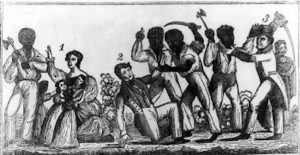 Carolina slaves arise.
Carolina slaves arise.
1739, Stono Rebellion, south of Charles Town, SC, results in 25 whites and 35-50 blacks killed, September. Kongo-born slaves led by Jemmy set out for the promise of freedom in Spanish Florida. Intercepted by militia at Edisto river. Most executed; some sold to West Indies.
In response, legislature bans import of African slaves for 10 years, and restricts slave assembly and education. Also requires governor’s approval of individual manumission, greatly shrinking that door to freedom.
1739, Britain, complaining about limited access to Spain’s West Indies ports and lack of slave-trading profits despite holding Spain’s asiento, declares, in October, a new conflict with Spain, later dubbed the War of Jenkins’ Ear.
Sailing from Port Royal, Jamaica, Adm. Edward Vernon attacks, occupies and loots Portobelo, Nov. 22, then destroys its forts. This victory inspires the song “Rule Britannia.”
1740s, Saint-Domingue and Jamaica (a distant second) rise to become leading producers of world sugar. Saint-Domingue’s sugar exports to Bordeaux are almost equal to value of all exports from 13 colonies to Britain.
Estimated that livelihood of one million of France’s 25 million people depend directly on imports from Saint-Domingue. Among the most profitable of all European colonies in 1700s.
1740s, Creeks from Georgia and Alabama, and some Choctow and Yamasee move into northern Florida, from which original Timucua people have disappeared (due to disease and slave raids). New arrivals are called cimarrones by the Spanish at St. Augustine, which apparently morphs into “Seminole.”
Many runaway slaves from Carolina and Georgia Sea Islands establish their own villages, paying tribute to and developing a working relationship with Indians. While most are Gullah, they learn Seminole languages, share agricultural skills (including rice cultivation) and intermarry to an extent. They are later called Black Seminoles and will ally with Indians against the Americans.
1740, Liverpool begins to dominate Britain’s Atlantic triangular trade over Bristol and London. Traffic of about 50 slave ships annually in 1750s rises to 100 before the American Revolution (during which it declines), and finally peaks at 120 to 130 annually (perhaps half of all Liverpool shipping) in the two decades before the 1807 ban.
Total slave voyages, 1695-1807: Bristol, 2,200; London, 3,100; Liverpool, 5,300.
Prominent Liverpool slave merchants: Banker Thomas Leylin, credited with transporting 3,500 slaves to Jamaica alone between 1782 and 1807; his fortune estimated at £736,531 in 1826. Banking partner was also a slave merchant.
Also John Moss and John Gladstone who each owned large slave plantations in Demerara (present-day Guyana). Isaac Gascoyne, an army officer, is a leading Liverpool opponent of abolishing the slave trade in Parliament, 1799.
Total slave voyages, 1695-1807: Bristol, 2,200; London, 3,100; Liverpool, 5,300.
1740, Parliament passes Plantation Act, allowing Protestant aliens residing in Britain’s colonies for seven years to be recognized as “his Majesty’s natural born subjects of this Kingdom.” Colonial courts are empowered to determine if petitioners fulfill requirements. Not intended for Catholics, but Quakers and Jews can be citizens by this means.
Will serve as basis for U.S. Naturalization Act of 1790.
1740, From Georgia’s Fort Frederica, James Oglethorpe leads a well-equipped attack on Spanish at St. Augustine as part of War of Jenkins’ Ear, June. He captures Fort Mose, held by free blacks who retake and destroy the fort in a surprise counter assault.
Oglethorpe is forced to withdraw, leaving 56 cannon, when the Royal Navy commander pulls back blockading ships at advent of hurricane season.
1740, In present-day Sonora, Yaqui people who had long lived peacefully under Jesuit missionaries, revolt against encroaching Spanish settlers. More than 1,000 Spanish and 5,000 Yaquis die. Uneasy peace follows with Jesuits replaced by Franciscan priests in 1767.
1741, In a brutally cold New York winter, the governor’s house in Fort George (originally Fort Amsterdam) is set afire, March 8. This and other arsons are attributed to a slave conspiracy to burn the city, which leads to hysteria and then seizure of 150-plus African slaves and 20 lower-class whites. Slaves include many owned by prominent DeLancey, Philipse, Livingston, Roosevelt and Bayard families, some of whom speak in slaves’ defense.
Seventeen blacks are hanged and 13 burned at stake; 4 whites, including a tavern keeper, his wife and another woman, and a Catholic priest (Spanish “Popish” connection is suspected) are also hanged. More than 70 blacks and 7 whites are banished to Madeira and various Caribbean islands.
Frequent Names: The list of accused blacks includes 9 Toms, 7 Jacks, 7 Caesars, 6 Yorks, 6 Tobeys or Toneys, 5 Londons (and 1 Dublin), 5 Wills, 5 Fortunes, 5 Catos, 4 Quacks, 4 Pompeys, 3 Sams, 3 Cofis, 3 Sarahs and 2 Scipios.
Most names are assigned by masters. But “Cofi” and variations thereof are found throughout the 13 colonies and the Caribbean. It’s Akan for “Friday” and often given to boys born on that day (including Kofi Annan, former UN secretary general).
1741, Britain, in its most ambitious attack of War of Jenkins’ Ear, sends huge 186-ship fleet and 27,000 men (including 4,000 Virginian recruits under Lawrence Washington, George’s older half brother) from Jamaica with orders to seize Havana, Porto Bello, Vera Cruz and Cartagena de Indies.
Adm. Vernon and Gen. Thomas Wentworth decide to begin, in March, with Cartagena, key transfer port for Spain’s treasure fleets, defended by a much smaller force under Blas de Lezo.
Yellow fever kills much of the British force, including 90 percent of the Virginians. British do little better on the attack, losing 10 warships and 27 transports, with another 17 warships seriously damaged. They get past one major fort, but fail to reach the city’s bastions and withdraw to Jamaica, May 20. This disaster brings down Prime Minister Robert Walpole and helps ignite War of Austrian Succession.
1741, Jonathon Edwards’ sermon, “Sinners in the Hands of an Angry God,” electrifies revival crowd in Enfield, CT, July 8, heralding the Great Awakening in the 13 colonies.
George Whitefield, a particularly influential evangelist from England, delivers 18,000 sermons, many outside, on seven separate tours of 13 colonies through 1770.
Most of the leading preachers condone slavery, although they may oppose “abuse” of slaves. Samuel Davies of Virginia stands out for his conversion of hundreds of slaves to Christianity, support for their learning to read the Bible, and declaration of their “spiritual equality” with their masters. He establishes meeting houses in Virginia, 1748-1759, but they are not for slaves.
The movement works to fully engage individuals and congregations in their spiritual conversion. New England church attendance doubles to 50,000 in two years, with hundreds of new churches opening.
Great Awakening leaders help to found forerunners of Princeton, Rutgers, Columbia, Dartmouth and Brown colleges.
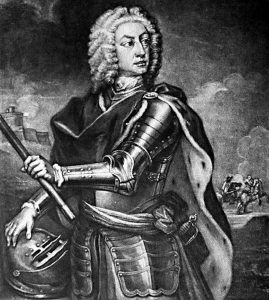 Oglethorpe in action.
Oglethorpe in action.
1742, Spain’s latest military thrust into Georgia (with 36 ships and 1,900 men) is defeated at Battle of Bloody Marsh near Fort Frederica on St. Simons Island by Oglethorpe’s much-smaller force of rangers, regulars, Indians and settlers. It is the last time Spanish from Florida threaten Georgia.
Oglethorpe departs for London a year later, never to return.
1742, Faneuil Hall, built by Peter Faneuil largely with slave labor, opens in Boston. Peter and his uncle, Andrew, are major merchants in the Triangular Trade, smuggling slaves from Africa to the West Indies.
The upstairs Assembly Room becomes a gathering place for proponents of revolution in 1774.
1747, London-based Richard Oswald leads a group of fellow Scots to buy Bunce Island slave factory in the Sierra Leone river estuary, previously operated by the Royal African Company.
Wolof captives gathered here are experienced in river rice cultivation and thus sought by rice plantation masters of South Carolina’s Low Country.
One of these rice planters, Henry Laurens, becomes Oswald’s agent in Charles Town, selling slaves from Bunce Island to other planters and keeping 10% commission.
Revolutionary War story: Laurens is an American diplomat in 1780 who is captured by a British ship en route to Amsterdam, imprisoned in the Tower and eventually exchanged for Lord Cornwallis, Dec. 31, 1781.
Laurens’ son, John, is killed in a skirmish with the British near Beaufort, SC, August 1782. He had urged the Americans to enlist slaves for the Patriot effort and to ultimately free them, including 40 he was to inherit from his father.
In 1783, Laurens helps Benjamin Franklin and John Jay negotiate the Treaty of Paris. Oswald, Laurens’ old slave-trade partner, and liberal David Hartley are the principal British negotiators. Historians regard the treaty as highly favorable to the Americans.
In his will, Laurens manumits none of his 260 slaves, not even those his son might have freed.
1748, Montesquieu publishes De l'esprit des lois (On the Spirit of the Law) in Geneva. He draws such a clear argument for the end of slavery, as all humans are born equal, and so effectively mocks pro-slavery defenses that it will serve as a basic Enlightenment platform for abolitionists who arise over the next half century.
The book also argues for separation of the essential government powers: making laws (legislative), executing laws (executive) and resolving disputes under laws (judiciary). Montesquieu is later cited by James Madison and others as a basic inspiration in their redesign of the U.S. government via the Constitution.
1748, John Newton, future author of “Amazing Grace,” miraculously survives Atlantic storm on the disabled Greyhound, a frequent slaver bound for its homeport, Liverpool.
But the spiritual inspiration is not complete; he captains slave ships for several years before becoming a preacher and, eventually, embracing abolition.
